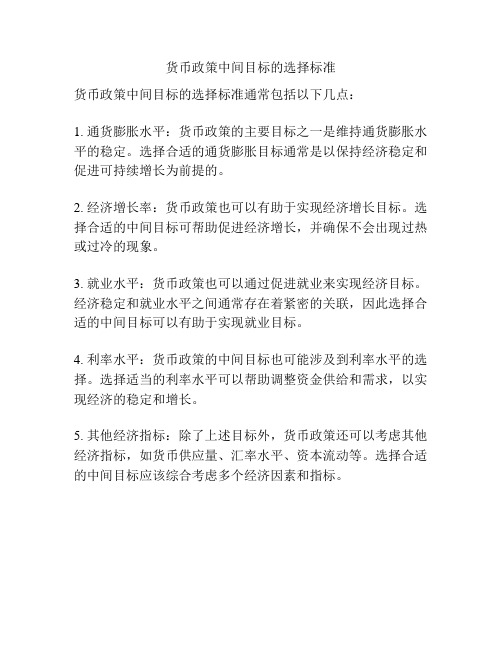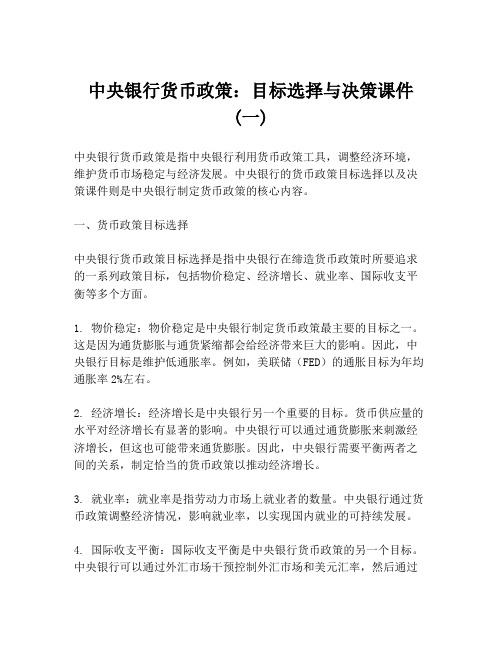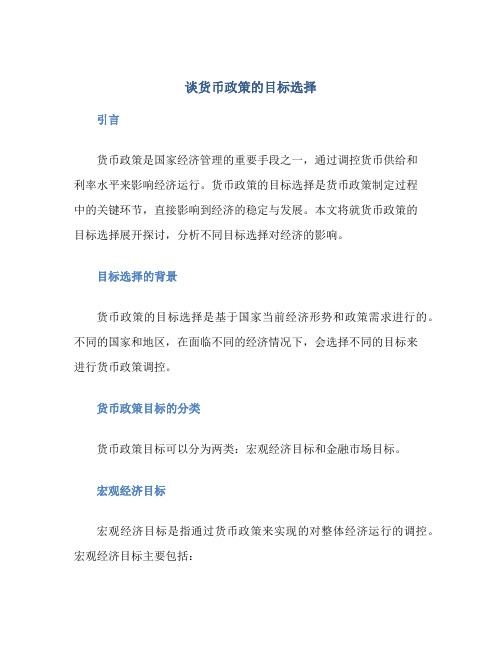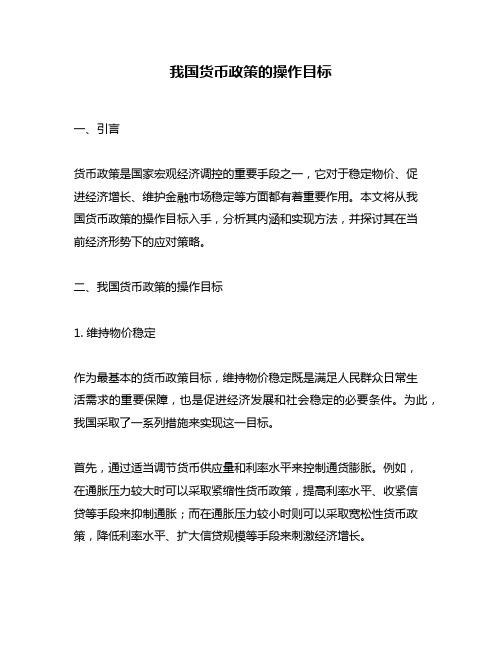中国货币政策目标的选择
货币政策中间目标的选择标准

货币政策中间目标的选择标准
货币政策中间目标的选择标准通常包括以下几点:
1. 通货膨胀水平:货币政策的主要目标之一是维持通货膨胀水平的稳定。
选择合适的通货膨胀目标通常是以保持经济稳定和促进可持续增长为前提的。
2. 经济增长率:货币政策也可以有助于实现经济增长目标。
选择合适的中间目标可帮助促进经济增长,并确保不会出现过热或过冷的现象。
3. 就业水平:货币政策也可以通过促进就业来实现经济目标。
经济稳定和就业水平之间通常存在着紧密的关联,因此选择合适的中间目标可以有助于实现就业目标。
4. 利率水平:货币政策的中间目标也可能涉及到利率水平的选择。
选择适当的利率水平可以帮助调整资金供给和需求,以实现经济的稳定和增长。
5. 其他经济指标:除了上述目标外,货币政策还可以考虑其他经济指标,如货币供应量、汇率水平、资本流动等。
选择合适的中间目标应该综合考虑多个经济因素和指标。
中央银行货币政策:目标选择与决策课件 (一)

中央银行货币政策:目标选择与决策课件(一)中央银行货币政策是指中央银行利用货币政策工具,调整经济环境,维护货币市场稳定与经济发展。
中央银行的货币政策目标选择以及决策课件则是中央银行制定货币政策的核心内容。
一、货币政策目标选择中央银行货币政策目标选择是指中央银行在缔造货币政策时所要追求的一系列政策目标,包括物价稳定、经济增长、就业率、国际收支平衡等多个方面。
1. 物价稳定:物价稳定是中央银行制定货币政策最主要的目标之一。
这是因为通货膨胀与通货紧缩都会给经济带来巨大的影响。
因此,中央银行目标是维护低通胀率。
例如,美联储(FED)的通胀目标为年均通胀率2%左右。
2. 经济增长:经济增长是中央银行另一个重要的目标。
货币供应量的水平对经济增长有显著的影响。
中央银行可以通过通货膨胀来刺激经济增长,但这也可能带来通货膨胀。
因此,中央银行需要平衡两者之间的关系,制定恰当的货币政策以推动经济增长。
3. 就业率:就业率是指劳动力市场上就业者的数量。
中央银行通过货币政策调整经济情况,影响就业率,以实现国内就业的可持续发展。
4. 国际收支平衡:国际收支平衡是中央银行货币政策的另一个目标。
中央银行可以通过外汇市场干预控制外汇市场和美元汇率,然后通过货币政策来调整出口和进口的量,以实现国际收支平衡。
二、决策课件中央银行货币政策决策课件是中央银行货币政策体系中的关键部分。
中央银行采用多种方法和工具来制定货币政策。
最常见的方法包括两种类型:市场操作和直接定价等级的措施。
市场操作是指中央银行在开放市场操作中买卖国债或其他财政证券以调节利率和货币供应。
直接定价等级的措施则是直接改变固定定价等级的值。
对于中央银行决策课件的制定,要充分考虑经济、政治、市场等多个方面因素的影响。
它主要涵盖以下几个方面:1. 政策意见:中央银行货币决策者研究,制定并确定中央银行的货币政策意见2. 困境分析:中央银行在制定货币政策时要谨慎考虑各种问题,包括通货膨胀式货币供应量、就业型货币政策等。
基于金融科技视角下我国货币政策中介目标的选择研究

基于金融科技视角下我国货币政策中介目标的选择研究随着金融科技的迅速发展,各国货币政策的中介目标也在不断演变。
在我国,货币政策的中介目标主要包括物价稳定、经济增长和金融稳定三个方面。
本文将从金融科技的视角出发,探讨我国货币政策中介目标的选择。
首先,物价稳定是我国货币政策的首要目标。
物价稳定是指物价水平在长期内保持相对稳定,通货膨胀率在一个可接受的范围内波动。
物价稳定可以保证货币的稳定性,并且有利于促进经济增长和社会稳定。
在金融科技发展的背景下,物价稳定的重要性更加凸显。
随着数字支付的发展,支付方式更加便捷和普及,货币流通速度会加快,对物价的影响也会更加显著。
因此,在执行货币政策时,要注意防范数字货币等金融工具对通货膨胀率的影响。
其次,经济增长是我国货币政策的长期目标。
经济增长可以实现国家的繁荣和人民的富裕。
在金融科技的时代,数字技术的发展和应用,会使得经济增长更加便利和高效。
特别是在人民币国际化进程中,数字货币和金融科技创新必将发挥更加重要的作用。
因此,在执行货币政策时,要注重科技创新,加强数字化经济发展,以促进经济的长期增长。
最后,金融稳定是我国货币政策的重要目标之一。
金融稳定是指金融体系的健康稳定运行,避免经济震荡和金融危机。
在数字金融时代,金融系统的风险和不稳定性也会随之增加。
因此,在执行货币政策时,要注重金融风险的监测和管理,加强金融监管,以保障金融体系的稳定运行。
综上所述,金融科技给我国货币政策的中介目标带来了新的挑战和机遇。
在执行货币政策时,需要考虑数字技术的影响,注重科技创新和金融稳定,以实现物价稳定、经济增长和金融稳定三个目标的协同发展。
货币政策目标的选择与通货膨胀目标制

货币政策目标的选择与通货膨胀目标制在大部分国家都实行通货膨胀单一目标制的情况下,我国仍坚持多目标的货币政策框架。
实行通货膨胀目标制的国家经过一段时间实践后通货膨胀的记录得到改善,我国多目标的货币目标依然冲突不断。
在2008年金融危机后,我国再次选择了首要保持经济增长的货币政策,结果造成了我国2011年居高不下的通货膨胀。
但由于我国正处于改革期,通货膨胀目标制并不适合我国的情况,央行要采取其他措施来锚定公众通货膨胀预期。
标签:货币政策目标通货膨胀目标制通货膨胀一、引言过去十年间,为了管理并稳定通货膨胀预期,各国央行开始采取新的货币政策——通货膨胀目标制。
中国央行货币政策采取“稳定物价、充分就业、经济增长和国际收支平衡”的多目标制,货币政策工具形式也表现为多样化。
稳定物价在很多国家是首要的任务,但是在我国一旦经济出现问题,首先牺牲的就是物价指数。
2008年金融危机发生以来,为了保持经济的增长,我国实行宽松的货币政策,导致了我国物价指数急剧上涨。
我国货币政策有没有可能实现单一目标成为一个值得探索的问题,近年来有不少学者开始对我国实行通货膨胀目标制的可能性进行了相关的探讨。
二、通货膨胀目标制1.通货膨胀目标制特点通货膨胀目标制不同于传统的货币政策,货币当局根据心理学中公众普遍存在的锚定效应直接设立通货膨胀目标值或目标区间,不再运用中介目标对货币政策进行调整。
央行操作过程的关键在于提高对未来通货膨胀和公众通胀预期预测的准确程度。
首先货币当局设立明确的通货膨胀目标值或目标区间作为公众通胀预期的一个名义锚,其次根据经济系统和相关模型预测未来的通货膨胀率,最后根据预测结果调整货币政策。
如果预测的通胀率大于设定的通胀目标值或目标区间的最大值,货币当局采取紧缩的货币政策;如果预测的通胀率低于设定的目标值或目标区间的最小值,货币当局采取扩张性的货币政策;而如果预测的通胀率接近设定的目标制或在目标区间范围之内,货币当局就保持原来的货币政策不变。
中央银行的货币政策目标及其选择

02 03
加强与其他政策的协调配合
未来,我国中央银行将更加注重货币政策与财政政策、产 业政策等其他政策的协调配合,形成政策合力,共同推动 经济发展。
推动金融市场发展和金融产品创新
未来,我国中央银行将继续推动金融市场发展和金融产品 创新,为货币政策实施提供更加广阔的空间和更加多样化 的工具。同时,将加强对金融市场的监管和风险防范,确 保金融市场的稳定和健康发展。
促进国际贸易和投资便利化
通过货币政策的国际合作和协调,推动国际贸易和投资便利 化,促进全球经济一体化和共同发展。
03
货币政策目标的选择依据
宏观经济形势分析
80%
经济增长
关注国内生产总值(GDP)增长 率、就业情况等,以评估经济总体 运行状况。
100%
通货膨胀
通过消费者价格指数(CPI)、生 产者价格指数(PPI)等指标,监 测物价水平及变动趋势。
与金融监管政策的协调配合
中央银行与金融监管机构加强合作,共同维护金融市场的 稳定和安全,防范金融风险对货币政策的冲击。
THANK YOU
感谢聆听
实现充分就业目标
通过实施积极的货币政策,刺激经济 增长,创造更多的就业机会,降低失 业率,实现充分就业目标。
提高就业质量
通过货币政策的引导,促进劳动力市 场的完善和人力资源的开发,提高就 业质量和劳动者素质。
国际收支平衡
保持国际收支基本平衡
通过实施适当的货币政策,调控外汇市场供求关系,保持国 际收支基本平衡,维护国家经济安全和金融稳定。
要点三
定向降准
中央银行针对某一金融领域或金融行 业进行的一次央行货币政策调整,目 的是降低存款准备金率。
加强与其他政策的协调配合
谈货币政策的目标选择

谈货币政策的目标选择引言货币政策是国家经济管理的重要手段之一,通过调控货币供给和利率水平来影响经济运行。
货币政策的目标选择是货币政策制定过程中的关键环节,直接影响到经济的稳定与发展。
本文将就货币政策的目标选择展开探讨,分析不同目标选择对经济的影响。
目标选择的背景货币政策的目标选择是基于国家当前经济形势和政策需求进行的。
不同的国家和地区,在面临不同的经济情况下,会选择不同的目标来进行货币政策调控。
货币政策目标的分类货币政策目标可以分为两类:宏观经济目标和金融市场目标。
宏观经济目标宏观经济目标是指通过货币政策来实现的对整体经济运行的调控。
宏观经济目标主要包括:1.保持物价稳定。
物价稳定是货币政策的一项重要目标,通过控制通货膨胀水平来实现价格稳定。
2.促进经济增长。
货币政策可以通过调控利率和货币供给来促进经济增长,刺激投资和消费。
3.维护就业稳定。
货币政策的目标之一是维护就业市场的稳定,通过调控货币供给和利率水平来支持就业。
金融市场目标金融市场目标是指通过货币政策来改善金融市场的运行状况。
金融市场目标主要包括:1.维护金融稳定。
货币政策可以通过调控利率和货币供给来维护金融市场的稳定,防止金融风险的发生。
2.支持金融体系发展。
货币政策可以通过提供充足的流动性和稳定的金融环境,支持金融机构的发展和创新。
3.促进国际支付平衡。
货币政策可以通过调控货币供给和汇率水平来促进国际支付平衡,维护国际收支的平衡。
目标选择的原则货币政策目标选择应遵循以下几个原则:1.统筹兼顾。
货币政策的目标选择应考虑到不同目标之间的相互影响,实现多目标的统一。
2.适应变化。
货币政策目标选择应根据经济形势的变化和政策需求的变化进行调整和变化。
3.科学决策。
货币政策目标选择应基于充分的数据和科学的分析,确保政策选择的科学性和有效性。
目标选择的影响因素货币政策目标选择受到以下因素的影响:1.经济形势。
货币政策目标选择应根据国家当前的经济形势进行调整,如经济增长速度、通货膨胀水平等。
我国货币政策的目标

我国货币政策的目标我国货币政策的目标是中国中央银行或者货币当局采取的货币政策的最终目标。
包含经济的增长、就业充分、稳定的物价水平、稳定的利率、稳定的汇率、平衡国际收支。
在实践中,货币政策目标的选择有两种,一是以稳定币为首要基本目标的单一目标;另一个是双重目标,就是稳定货币又兼顾经济的发展。
通过货币政策的制定和实施预期达到的最终目标是央行货币政策制定者的最高行为准则。
货币政策的目标一般可以概括为:物价稳定、充分就业、经济增长、国际收支和金融稳定。
价格稳定是指将价格总体水平的变化短期控制在较小范围内,不发生显着或剧烈波动。
充分就业是指将失业率降低到一个社会可以承受的水平。
经济增长是指经济长期稳定增长。
在没有重大波动或衰退的情况下,一个时期比另一个时期要好。
货币政策的目标包括:最终目标、中期目标和操作目标。
从央行货币政策的历史演变来看,无论是单目标、双目标还是多目标,都离不开当时的经济社会环境和当时面临的最突出的基本矛盾时间。
但是,货币政策要保持足够的稳定性和连续性,政策目标不能有偏差、不能波动。
央行虽然不能直接带来这些条件,但可以针对可能对其产生影响的变量制定不同的政策。
这两种货币政策标准之间经常存在冲突。
这一政策可以实现一个目标,但也使另一个目标更难实现。
经济增长是指经济长期稳定增长。
一个时期优于另一个时期,没有大起大落,也没有衰退。
货币政策一般分为以下三种:1.扩张性货币政策。
是指降低法定存款准备金率和利率,从而扩大信贷支出规模,增加货币供应量,刺激投资和消费。
2.收紧货币政策。
这意味着提高法定存款准备金率和利率,从而减少信贷支出和货币供应规模,抑制投资和消费。
3.稳健的货币政策。
在货币政策措施方面,要确保货币供应量或利率的稳定。
我国货币政策的操作目标

我国货币政策的操作目标一、引言货币政策是国家宏观经济调控的重要手段之一,它对于稳定物价、促进经济增长、维护金融市场稳定等方面都有着重要作用。
本文将从我国货币政策的操作目标入手,分析其内涵和实现方法,并探讨其在当前经济形势下的应对策略。
二、我国货币政策的操作目标1. 维持物价稳定作为最基本的货币政策目标,维持物价稳定既是满足人民群众日常生活需求的重要保障,也是促进经济发展和社会稳定的必要条件。
为此,我国采取了一系列措施来实现这一目标。
首先,通过适当调节货币供应量和利率水平来控制通货膨胀。
例如,在通胀压力较大时可以采取紧缩性货币政策,提高利率水平、收紧信贷等手段来抑制通胀;而在通胀压力较小时则可以采取宽松性货币政策,降低利率水平、扩大信贷规模等手段来刺激经济增长。
其次,加强物价监管和调控,防止价格波动对社会稳定造成不良影响。
例如,加强价格信息收集和发布,及时公布物价变动情况,引导市场预期;同时加大对价格垄断、虚假宣传等违法行为的打击力度,维护市场秩序。
2. 促进经济增长货币政策对经济增长的促进作用主要通过调节信贷规模、利率水平等手段来实现。
具体来说,货币政策可以通过以下方式促进经济增长:首先,扩大信贷规模。
当经济发展面临信贷紧缩时,货币政策可以采取宽松性措施来扩大信贷规模,刺激投资和消费需求的增长。
其次,降低利率水平。
当经济发展面临投资不足时,货币政策可以通过降低利率水平来降低融资成本,刺激企业投资意愿和消费者购买欲望。
3. 维护金融市场稳定金融市场稳定是货币政策的重要目标之一。
金融市场的不稳定会对经济发展和社会稳定产生负面影响,因此,货币政策需要采取措施来维护金融市场的稳定。
首先,加强监管力度。
货币政策需要通过加强对金融机构的监管来防范风险,减少系统性风险的发生。
其次,提高市场透明度。
货币政策需要通过加强信息披露和公开透明度来提高市场参与者的信心和预期,减少投资者恐慌情绪的出现。
4. 保障人民币汇率稳定人民币汇率稳定是我国货币政策的重要目标之一。
- 1、下载文档前请自行甄别文档内容的完整性,平台不提供额外的编辑、内容补充、找答案等附加服务。
- 2、"仅部分预览"的文档,不可在线预览部分如存在完整性等问题,可反馈申请退款(可完整预览的文档不适用该条件!)。
- 3、如文档侵犯您的权益,请联系客服反馈,我们会尽快为您处理(人工客服工作时间:9:00-18:30)。
中国货币政策目标的选择摘要货币政策在国家宏观经济政策中发挥着十分重要的作用,它是国家宏观调控的重要手段之一。
货币政策目标作为货币政策的核心,对其选择的科学与正确与否尤为重要。
自中央银行产生以来,货币政策最终目标的选择便是各国宏观经济运行中的核心问题。
在长期的实践中,逐渐形成了传统的四大货币政策的最终目标,即:物价稳定、充分就业、经济增长和平衡国际收支。
货币政策的这四大目标之间并非毫无联系的独立存在的,它们之间既有统一性又有矛盾性。
因此,各国在宏观经济政策的制定和运行时,便不可能兼顾所有目标,这就出现了货币政策目标的选择问题。
在一个国家的所处的经济环境、面临的经济问题和推崇的经济理论共同作用的结果下,不同的国家,不同的历史时期的货币政策目标的选择是不同的。
大多数西方国家政府在制定货币政策时,总会根据当时的经济形势对目标有所侧重。
关于中国货币政策最终目标的选择,理论界一直存在着不同的看法和争论,大致上可分为单一目标论、双重目标论和多重目标论三种观点。
1984年以来,中国货币政策无论从选择、制定或是执行、实施均处在一条艰难曲折的道路上探索。
后来随着1995年《中华人民共和国中国人民银行法》的颁布,中国货币政策目标正式以法律形式确定为“保持货币币值稳定,并以此促进经济增长”。
这一目标组合,既充分遵循了货币政策目标选择的一般规律,又符合现阶段国情与大力发展社会主义市场经济,促进国民经济持续、快速、健康发展的内在要求。
实践证明,此目标是我国体制转换时期货币政策最终目标的科学的具有充分可行性的选择。
货币政策涉及面广,对经济的影响广泛,在对货币政策目标选择的过程中既不能一味地复制西方的具体经验,也不能盲目独断,我行我素。
最科学的方法时在借鉴优秀经验的基础上结合中国实际制定符合我国实际的货币政策目标。
Abstract:Monetary policy, which is the major means of macro regulation and control, plays a very important role in the national macro-economic policies. Monetary policy target is the core of the monetary policy, and a right and scientific choice of the target is particularly important. Since the central bank has been established, choosing the ultimate target of monetary policy has become the key point of macro-economy in every country. During a long-time practice, four traditional ultimate targets of monetary policy have formed, which are price stability, full employment, economic growth and balance of international payments. These four targets of monetary policy do not exist independently; on the contrary, they are the unity of a contradiction. Therefore, when countries make and implement their macroeconomic policies, they can not cover all the targets. As a result, they have to face a problem of choosing the monetary policy targets. With the influence of the economic environment, the current economic problems and the well-acclaimed economic theory, different countries in different periods willprefer different monetary policy targets. Most Western country governments will make monetary policy in accordance with the economic situation of that time. With regard to the ultimate goal of China's monetary policy options, economic theorists hold different views which can be generally divided into single-target theory, the twin goals of theory and multiple goals. Since 1984, China's monetary policy exploration in terms of selection, formulation or implementation has been in a difficult and tortuous path. Subsequently, in 1995, "Law of the People’s Republic of China on the People’s Bank of China" defined the monetary policy target of China as "to maintain stability of the currency and thereby promote economic growth." To combine the two goals, not only obeys the general rule of monetary policy objective choice, but also conforms to the present country condition and meets the innate demand of developing the socialist market economy and sustaining rapid-grown, healthy national economy. Practice has proved that this target is a science-based choice with full possibility to carry out during the period of the transition of economic structure in China. In conclusion, monetary policy covers wide range aspects of the society and has large effect on the economy. So when select the monetary policy targets, China can neither blindly copy the Western countries’ specific experience nor persist in its own way. The most scientific way to set monetary policy goals is to combine the right experience with the real situation of our country.正文:一、导言作为国家宏观经济政策之一的货币政策在一国的经济运行及宏观调控中发挥着重大的作用,而对于作为其核心的货币政策目标的选择的正确与否更是重中之重。
制定货币政策,首先必须明确货币政策的方向和所要达到的目的,即所要实现的目标。
确切的说,货币政策目标应该是一个由最终目标,中介目标和操作目标有机组成的目标体系。
但一般来说,货币政策目标是指最终目标。
它是中央银行通过货币政策操作而最终要达到的宏观经济目标。
货币政策最终目标的选择,决定了货币政策效力如何以及经济发展的方向。
从传统意义上讲,货币政策的最终目标一般有四个:保持币值稳定、促进经济增长、实现充分就业和平衡国际收支[1]。
这四个目标也是基本的宏观经济目标,一直以来都是各国政府和中央银行力图实现的理想状态。
但从各国的具体情况来看,不仅在表述上这四个目标存在差异,具体做法也各有所不同,这一系列差异的原因便涉及到了货币政策目标的选择问题。
中国目前同样也面临着货币政策最终目标的选择的适当性和科学性问题。
二、传统的货币政策目标由于各国经济的不断发展和长期实践,逐渐形成了传统的四个货币政策目标:物价稳定、充分就业、经济增长和平衡国际收支。
1、物价稳定物价稳定就是指一般物价水平在短期内不发生显著的或者剧烈的上下波动。
这里的物价是指一般物价水平,而不是指某种特定商品的价格。
物价稳定有助于企业和消费者的理性投资和消费,达到市场资源的合理有效的配置;其次,物价稳定有助于降低个人和企业把资源从生产性用途转移到非生产性用途的可能,从而促进经济增长;第三,物价稳定有助于减少通货膨胀所带来的损失;第四,物价稳定有助于防止财富和收入的大量和无序的重新分配;最后,物价稳定有利于保持社会和政治的稳定。
因此,无论任何一个国家,都不愿国内的物价水平不断的上涨,这些国家总是把物价上涨的幅度控制在最小的范围内,以此来实现经济增长的目标。
2、充分就业所谓充分就业就是指任何愿意工作并有能力工作的人都可以得到一个有报酬的工作,这是政府宏观经济政策的重要目标。
如果社会的就业不充分,那表明存在着社会资源尤其是劳动力资源存在着浪费的现象。
由于社会的不充分就业,会带来失业者生活质量的下降并由此引发一系列社会矛盾而导致社会的不稳定。
就业的不充分固然有其危害性,但国家并不是把零失业率作为它的追求目标。
